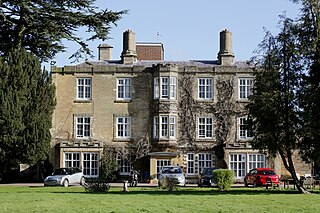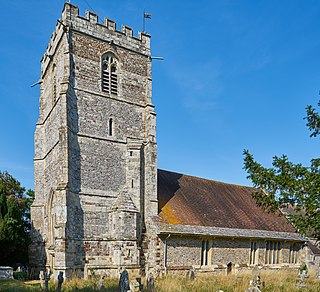
An abbey is a type of monastery used by members of a religious order under the governance of an abbot or abbess. Abbeys provide a complex of buildings and land for religious activities, work, and housing of Christian monks and nuns.

Battle Abbey is a partially ruined Benedictine abbey in Battle, East Sussex, England. The abbey was built on the site of the Battle of Hastings and dedicated to St Martin of Tours. It is a Scheduled Monument.

Buckfast Abbey forms part of an active Benedictine monastery at Buckfast, near Buckfastleigh, Devon, England. Buckfast first became home to an abbey in 1018. The first Benedictine abbey was followed by a Savignac abbey constructed on the site of the current abbey in 1134. The monastery was surrendered for dissolution in 1539, with the monastic buildings stripped and left as ruins, before being finally demolished. The former abbey site was used as a quarry, and later became home to a Gothic mansion house.

Shenley Brook End is a village, district and wider civil parish in Milton Keynes, Buckinghamshire, England. Together with its neighbouring parish, Shenley Church End and the districts of Shenley Wood and Shenley Lodge, the districts are collectively known as "The Shenleys".

Abbotsbury Abbey, dedicated to Saint Peter, was a Benedictine monastery in the village of Abbotsbury in Dorset, England. The abbey was founded in the 11th century by King Cnut's thegn Orc and his wife Tola, who handsomely endowed the monastery with lands in the area. The abbey prospered and became a local centre of power, controlling eight manor houses and villages. During the later Middle Ages, the abbey suffered much misfortune. In the time of the dissolution of the monasteries, the last abbot surrendered the abbey and the site became the property of Sir Giles Strangways.

Cluny Abbey is a former Benedictine monastery in Cluny, Saône-et-Loire, France. It was dedicated to St Peter.

Bradwell Abbey or Bradwell Priory is a Scheduled Ancient Monument, urban studies site, district and former civil parish in Milton Keynes, Buckinghamshire, England. The site was once the location of a Benedictine priory, founded in 1155.

This history of Milton Keynes details its development from the earliest human settlements, through the plans for a 'new city' for 250,000 people in south central England, its subsequent urban design and development, to the present day..

St. Giles's Church is a small 16th century Church of England church in Tattenhoe, a district in the west of Milton Keynes, Buckinghamshire, England. It is of modest size but is a Grade 2* listed building.
Dureford Abbey, in Sussex, England, was a Premonstratensian monastery. It was founded by Henry Hussey who in 1161 granted land to the abbot of Welbeck Abbey, to establish the new community near Rogate, Sussex.

Hatfield Broad Oak Priory, or Hatfield Regis Priory, is a former Benedictine priory in Hatfield Broad Oak, Essex, England. Founded by 1139, it was dissolved in 1536 as part of Henry VIII's dissolution of the monasteries.

Goldcliff Priory was a Benedictine monastery in Goldcliff, Newport, South Wales, founded in 1113 by Robert de Chandos and subject to the Abbey of Bec in Normandy. The priory was situated on the site now occupied by Hill Farm, to the south of the current farmhouse, on the prominent knoll of high ground next to the sea. As late as the 1950s Hando remarked that outlines of buildings which were probably part of the priory could still be seen in grass patterns or crop marks at certain times of the year. By the 1970s the only remaining physical remnant of the priory was to be found as part of a cellar in the farm house.

Tickford Priory was a medieval monastic house in Newport Pagnell in Buckinghamshire, England.

Cranborne Priory was a priory in Cranborne in Dorset, England. The priory church survives as Cranborne's parish church, the Church of St Mary and St Bartholomew, and is a Grade I listed building, with parts of the building dating back to the 12th century.

St. Mary Magdalen was a Benedictine priory in Lincoln, England. Along with Sandtoft Priory and Hanes Cell, it was a Lincolnshire cell of St Mary's Abbey in York, England. A surviving building, once owned by the priory, is Monks' Abbey, Lincoln.

St. James Priory, also known as Derby Cluniac Priory, was a Benedictine monastery, formerly located in what is now Derby City Centre. It existed until the Dissolution of the Monasteries.

Morville Priory was a small Benedictine monastery in Shropshire, a cell of Shrewsbury Abbey.

















